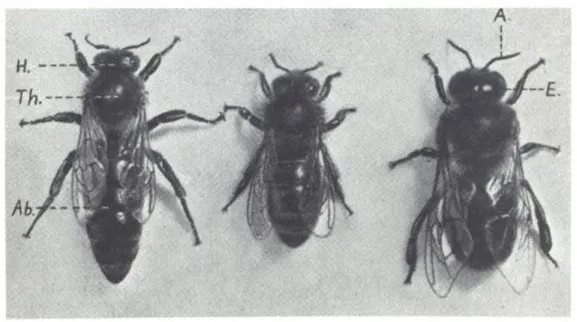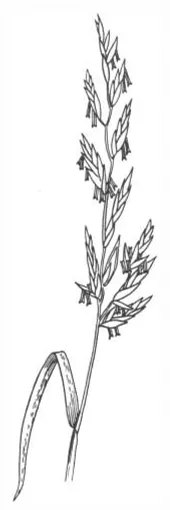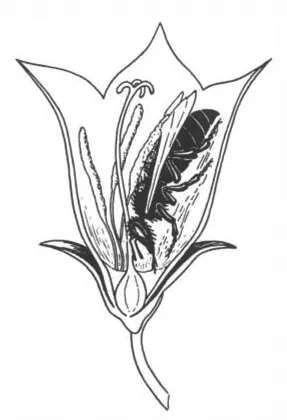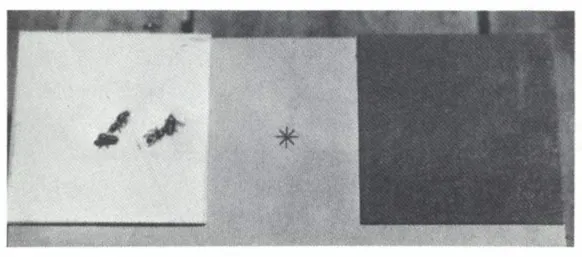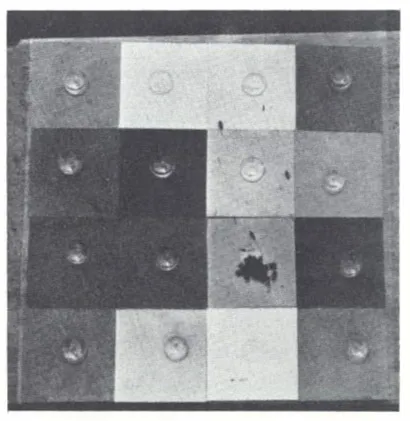1. The Color Sense of Bees
The honeybee, living in its beehive, is a social insect. In an ordinary beehive there are about sixty thousand bees, but only one is a fully developed female. This is the queen, the only egg-laying insect in the colony. The males or drones are larger, more plump, and a little stupid and lazy. All of the remaining bees are workers (Figure 1). The workers are not able to produce eggs, under normal circumstances, for their ovaries are small and undeveloped; but in other respects they are females, with the typical instincts of females; they do all the work in the hive. They feed the larvae, they build the honeycomb, they are the charwomen of the hive; and it is only these worker bees that fly out to gather honey and pollen as food for the colony.
Figure 1. Left to right: The queen. The worker bee. The drone. H., head; Th., thorax; Ab., abdomen; A., antenna; E., eye.
The worker bees find the food by visiting flowers. Here some gather nectar droplets with a high concentration of sugar. Others collect pollen, since they also need protein for the growing larvae. But in taking their food they do not behave like plunderers. They reciprocate and perform a service for the plants by effecting the pollination—flying from one flower to the next and carrying the pollen adhering to their bodies.
Figure 2. Grass blossoms as an example of blossoms pollinated by the wind.
Figure 3. The blossoms pollinated by insects are the larger and more conspicuously colored ones.
It is well known that there are two main types of “flowers” among the higher plants. Many plants have small green blossoms without any scent, and the transfer of pollen is effected by the air (Figure 2). Such plants produce an abundance of pollen, which is spread by the wind and comes by chance to other blossoms of the same species. Other plants have conspicuous, brightly colored blossoms or a striking scent, or both, and it is these that we ordinarily call flowers (Figure 3). Only such flowers produce nectar and are therefore visited by insects, which effect the pollination by flying from one flower to the next (Figure 4). Biologists have long believed that flowers are colored and scented to make them more striking for their insect visitors. In this way the insects can more easily find the flowers and get their food; and the pollination is also assured.
But this view has not been accepted by all biologists. About 1910 a famous ophthalmologist, Professor C. von Hess, performed many experiments on fishes, insects, and other lower animals. He tested them while they were in a positively phototactic condition—that is, under circumstances where they moved into the brightest available light. He found that in a spectrum the animals always collected in the green and the yellow-green region, which is the brightest part of the spectrum for a color-blind human eye. Therefore, von Hess asserted, fishes and invertebrates, and in particular bees, are totally color-blind. If this were true, the colors of flowers would have no biological significance. But I could not believe it, and my skepticism was the first motive which led me to begin my studies of bees about 1910. I tried to find out whether bees have a color sense.
Figure 4. Nectar is produced in the bottom of a flower, so that as they suck it up the visiting insects come in contact with the pollen.
By the scent of a little honey it is possible to attract bees to an experimental table. Here we can feed them on a piece of blue cardboard, for example. They suck up the food and, after carrying it back to the hive, give it to the other bees. The bees return again and again to the rich source of food which they have discovered. We let them do so for some time, and then we take away the blue card scented with honey and put out two new, clean pieces of cardboard at the site of the former feeding place—on the left a blue card, and on the right a red one. If the bees remember that they found food on blue, and if they are able to distinguish between red and blue, they should now alight on the blue card. This is exactly what happens (Figure 5).
Figure 5. Bees fed previously on a blue card in the middle of the table (*) alight on the clean blue cardboard without food (left). They distinguish it from a red cardboard (right).
This is an old experiment. It indicates that bees can distinguish colors, but it does not prove that they have a color sense, or color perception, for these are not always the same. Thus there are totally color-blind men, although they are very rare. They see objects as we would see them in a black-and-white photograph. Yet they can distinguish between red and blue, for red appears very dark to them, and blue much lighter. Hence we cannot learn from the experiment with bees which I have just described whether the bees have distinguished red from blue by color or by shade, as a color-blind man might do. To a totally color-blind man each color appears as a gray of a certain degree of brightness. We do not know what the brightness of our various pieces of colored cardboard may be for a color-blind insect. Therefore we perform the following experiment.
On our table we place a blue card and around it we arrange gray cards of all shades from white to black. On each card we set a little watch glass, but only the glass dish on the blue card contains food (sugar-water). In this way we train the bees to come to the color blue. Since bees have a very good memory for places we frequently change the relative positions of the cards. But the sugar is always placed on the blue card so that in every case the color indicates where food is to be found. After some hours we perform the decisive experiment. The cards and the glass dishes soiled by the bees are taken away. We place on the table a new series of clean cards of different shades of gray, each with an empty glass dish, and somewhere among them we place a clean, blue card provided, like all the others, with an empty glass dish. The bees remember the blue color and alight only on the blue card, distinguishing it from all shades of gray. This means that they have a true color sense.
This type of experiment has been criticized on the ground that the blue cardboard might have a specific scent by which the bees could recognize it. We cannot perceive any odor, but this does not prove that it is odorless for bees; we must therefore consider the possibility that the bees found the blue cardboard by smell, and not by color. But this is not the case. For we can repeat the experiment with a glass plate lying over the cards; if there were any scent it could not pass through the glass. But the outcome of the experiment is just the same as before (Figure 6).
Figure 6. Bees trained to the color blue alight on a clean blue cardboard without food and under glass—distinguishing it from all degrees of gray.
Training bees to come to food on orange, yellow, green, violet, or purple cardboard gives the same positive result. However, if we try to train bees to find their food on scarlet red, they alight not only on the red cardboard but also on black and on all the dark-gray cards in our arrangement. Thus red and black are the same to the eye of the bee; in other words, bees are red-blind. From these experiments it is clear that bees have a color sense, but that it is not quite the same as that of a normal human being.
To find out something more about the nature of color perception in bees, we modify our experiment. We train bees to find food on blue, and then we put on the table all the colored cards we have on hand, but no gray cards at all. The bees seek for blue, but it is surprising to see that they are unable to find it with certainty. They confuse blue cards with violet and purple ones. Furthermore, bees trained to yellow alight not only on yellow cards but on orange and green ones, too (von Frisch, 1915).
In 1927 Professor A. Kühn repeated my training experiments, but instead of colored cards he used a spectrum. He was able to confirm my results: that bees are red-blind, that they can distinguish other colors from all shades of gray, and that they confuse yellow with orange and green, or blue with violet. But by using spectral colors he discovered two new facts: First, he noted that there is a third quality of color in the narrow blue-green region (480–500 mμ1 ). Bees trained to blue-green distinguish it from blue and from yellow. I had overlooked this point because I had no suitable cardboard of this blue-green color. Second, he discovered a fourth quality in ultraviolet light. If bees on the experimental table are fed for some time in ultraviolet light, they alight on every spot irradiated by ultraviolet, even though this light is invisible to us; and they distinguish the ultraviolet from all shades of white or gray. It is a distinct color for the bees.
If we compare the color sense of bees and men, we find that the visible spectrum is shortened for bees in the red but that it is extended into the ultraviolet. In this way the visible region is merely shifted to shorter wave lengths. But a much more important difference seemed to be that the bee apparently sees only four different qualities of color: yellow, blue-green, blue, and ultraviolet (Figure 7).
In order to make a closer comparison between the color vision of bees and man, experiments with color mixtures2 would have been important. At the time we lacked adequate apparatus. Other problems pushed their way into the foreground and so it was thirty years before I induced K. Daumer to fill in these gaps and to resume with improved technique the training of bees to colors. Then for the second time we were made aware that improved methods brought better performance in the area of color vision. Daumer (1956) trained the bees individually. Doing so gives more clean-cut results, because the bees disturb one another when they are trained in groups. Customarily they flew through a window into a semidarkened room that held the training cabinet (Figure 8). A lamp inside the cabinet gave out white light, including ultraviolet which bees are able to see. The distribution of energy over the several spectral ranges was like that of sunlight. Four star-shaped openings in the lid of the cabinet were covered with glass transparent to ultraviolet. Upon them stood quartz feeding dishes, likewise transparent for ultraviolet (Figure 9). Each star could be illuminated from below with colored light from a narrow region of the spectrum or with a mixture of various spectral colors. After a bee had been trained to a given color, or to a mixed illumination, she was tested experimentally for her ability to distinguish this from other colors offered alongside it. In this experimental setup the bees were indeed able to differentiate orange, yellow, and green. Yet these colors are more alike for them than for man. For bees blue-green is a sharply contrasting separate color. Within the blue-violet and ultraviolet ranges bees can recognize several different hues. But they can see more than this. In order to comprehend such matters we require a short lesson in physiological optics.
Figure 7. The colors of a spectrum for the human eye (above) and for the eye of the bee (below). The numbers indicate the wave length of light in millimicrons, mμ (one micron = 0.0001 centimeters or 1/25000 inch). (From von Frisch, Tanzsprache und Orientierung der Bienen [Springer-Verlag, 1965], p. 486; Dance Language and Orientation of Bees [Harvard University Press, 1967], p. 475·)
Figure 8. Cabinet for training to color; inside it are the light source and the apparatus for mixing colors. In the top are four star-shaped openings that are covered by glass transparent to ultra-violet and that bear quartz vessels (transparent to ultraviolet) for food and water. After Daumer, 1956.
Figure 9. Bee at the feeding vessel on a star illuminated from beneath. After Daumer, 1956. (From von Frisch, Tanzsprache und Orientierung der Bienen [Springer-Verlag, 1965], p. 484.)
When white sunlight is beamed through a prism it acquires an orderly arrangement according to the wave length, and the colorful ribbon of the spectrum appears (Figure 10a). If by means of a lens we reunite all the colors, white is found again (Figure 10b). But if we bring together only the ends of the spectrum, namely red, of long wave length, and violet, of short wave length, then there are formed the purple colors, that do not occur in the spectrum (Figure 10c). The. s...

